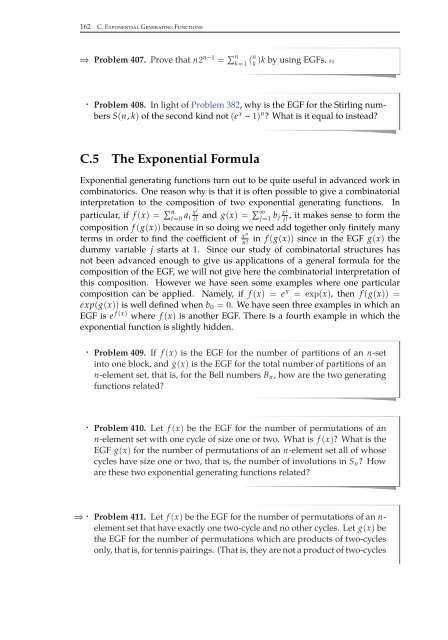Combinatorics Through Guided Discovery, 2004a
Combinatorics Through Guided Discovery, 2004a
Combinatorics Through Guided Discovery, 2004a
Create successful ePaper yourself
Turn your PDF publications into a flip-book with our unique Google optimized e-Paper software.
162 C. Exponential Generating Functions<br />
⇒<br />
Problem 407.<br />
Prove that n2 n−1 = ∑ n<br />
k=1 (n )k<br />
k<br />
by using EGFs. (h)<br />
· Problem 408. In light of Problem 382, why is the EGF for the Stirling numbers<br />
S(n, k) of the second kind not (e x − 1) n ? What is it equal to instead?<br />
C.5 The Exponential Formula<br />
Exponential generating functions turn out to be quite useful in advanced work in<br />
combinatorics. One reason why is that it is often possible to give a combinatorial<br />
interpretation to the composition of two exponential generating functions. In<br />
particular, if f (x) = ∑ n<br />
i=0 a i xi<br />
i!<br />
and g(x) = ∑ ∞<br />
j=1 b j x j<br />
j!<br />
, it makes sense to form the<br />
composition f (g(x)) because in so doing we need add together only finitely many<br />
terms in order to find the coefficient of xn<br />
n!<br />
in f (g(x)) since in the EGF g(x) the<br />
dummy variable j starts at 1. Since our study of combinatorial structures has<br />
not been advanced enough to give us applications of a general formula for the<br />
composition of the EGF, we will not give here the combinatorial interpretation of<br />
this composition. However we have seen some examples where one particular<br />
composition can be applied. Namely, if f (x) = e x = (x), then f (g(x)) =<br />
exp(g(x)) is well defined when b 0 =0. We have seen three examples in which an<br />
EGF is e f (x) where f (x) is another EGF. There is a fourth example in which the<br />
exponential function is slightly hidden.<br />
· Problem 409. If f (x) is the EGF for the number of partitions of an n-set<br />
into one block, and g(x) is the EGF for the total number of partitions of an<br />
n-element set, that is, for the Bell numbers B n , how are the two generating<br />
functions related?<br />
· Problem 410. Let f (x) be the EGF for the number of permutations of an<br />
n-element set with one cycle of size one or two. What is f (x)? What is the<br />
EGF g(x) for the number of permutations of an n-element set all of whose<br />
cycles have size one or two, that is, the number of involutions in S n ?How<br />
are these two exponential generating functions related?<br />
Problem 411.<br />
⇒ · Let f (x) be the EGF for the number of permutations of an n-<br />
element set that have exactly one two-cycle and no other cycles. Let g(x) be<br />
the EGF for the number of permutations which are products of two-cycles<br />
only, that is, for tennis pairings. (That is, they are not a product of two-cycles


















